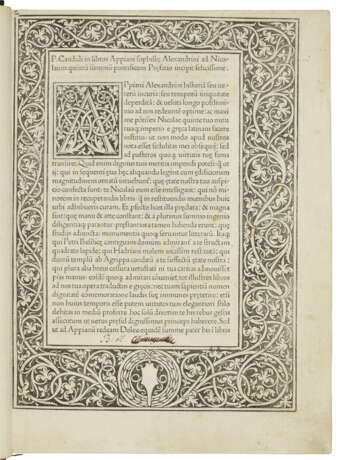ID 1105713
Lot 65 | APPIANUS (c.100-c.170)
Estimate value
£ 10 000 – 15 000
Historia Romana. -De bellis civilibus. Translated by Petrus Candidus Decembrius (1399-1477). Venice: Bernhard Maler (Pictor), Erhard Ratdolt, and Peter Löslein, 1477.
First complete edition and the first printing of part one, featuring the earliest known woodcut borders; a large copy, notably taller than others on the market or in the British Library. Appian's Greek narratives, describing Roman wars from the earliest times to the accession of Vespasian, were written in 24 books and survived in 10 with portions of others. Pier Candido Decembrio, his humanist translator, divided the surviving books into two parts: part two only was first printed by Vindelinus de Spira in 1472; part one was first printed separately by Peregrinus de Pasqualibus in 1495. Redgrave, Radolt's bibliographer, wrote: 'To my mind there are few printed books of any age which can be compared with the Appian of 1477, with its splendid black ink, its vellum-like paper, and the finished excellence of its typography' (p.13). It is one of Ratdolt's earliest Venetian imprints, following only Regiomontanus's Calendarium, and contains the first use of both of the fine woodcut border pieces.
Decembrio had been a pupil of the Byzantine scholar Manuel Chrysoloras, from whom he learned classical Greek. Chrysoloras single-handedly reintroduced the language and its literature to western Europe when he was invited to lecture in Florence in 1397, thereby heralding the Renaissance. He brought with him manuscripts of classical Greek texts as well as his knowledge of the language, later codified in his Erotemata grammar book. H 1307* [II, I]; GW 2290; BMC V 244; BSB-Ink A-651; Bod-inc A-363; Essling 221; IGI 763; Goff A-928; ISTC ia00928000.
2 parts in one volume, royal half-sheet quarto (281 x 202mm). 131 and 211 leaves (of 132 and 212, missing first blank in both parts). Full woodcut white-vine border on first title, three-sided woodcut white-vine border on second title, woodcut white-on-black initials in two sizes (small stain in last 3 leaves, with tiny repairs in final leaf with a few letters restored, very occasional faint staining, two opening leaves lightly washed). Brown crushed morocco by Capé, blindtooled to a gothic style, spine lettered in gilt, gilt edges (minor scuffing at extremities). Provenance: occasional contemporary marginal annotations – 18th-century library inscription (deleted from first leaf) – Herschel V. Jones (1861-1928, bookplate; sold Anderson Galleries, NY, 2-3 December 1918, lot 76).
| Address of auction |
CHRISTIE'S 8 King Street, St. James's SW1Y 6QT London United Kingdom | ||||
|---|---|---|---|---|---|
| Preview |
| ||||
| Phone | +44 (0)20 7839 9060 | ||||
| Buyer Premium | see on Website | ||||
| Conditions of purchase | Conditions of purchase |



